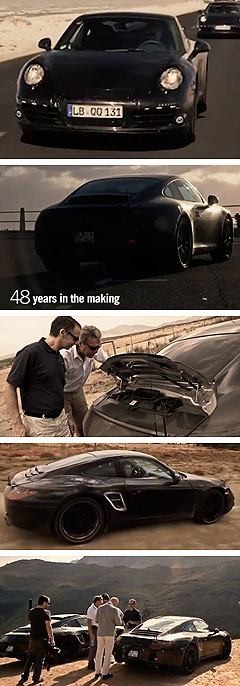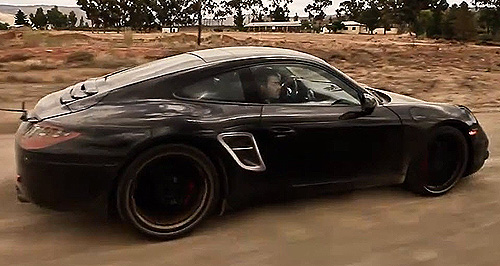Make / Model Search
Future models - Porsche - 911First look: Seven-speed manual for new Porsche 911Next 911 teased in official development video as Porsche begins Frankfurt countdown20 Jul 2011 PORSCHE’S next-generation 911 has broken cover in an officially sanctioned video, confirming key technical details of the all-new 991-codenamed model ahead of its global reveal at the Frankfurt motor show in September. Both coupe and cabriolet versions of Porsche’s redesigned two-door sportscar flagship – at least until the plug-in 918 Spyder hybrid and a coupe version of the next Panamera arrive – can be seen wearing only partial disguise in a 1:22 video shot by Tangent Vector during final 991 prototype validation testing in South Africa recently. The Porsche-approved video combines with a flurry of recent spy shots and a handful of ‘first drive’ reports from selected media outlets invited as passengers on the recent pre-production development drive provide a valuable insight into the look and mechanical make-up of what Porsche says is the first completely new 911 in 48 years. Due on sale in Australia in early 2012 following its global launch in the US in November, the 991 911 conceals its significantly longer wheelbase under a sleek new body that is unmistakably 911 but features a number of subtle design changes. Biggest visual difference is the 991’s pointier front-end and more pronounced headlight ‘turrets’, continuing the existing 997’s move away from the radical bluff-nosed, stylised-headlight 996-series of 1998 – the first liquid-cooled 911 – and back towards the original ‘bug-eyed’ 911 of 1963. Although two-thirds of its ‘substantial’ (but still secret) extra overall length is said to be contained behind the driver, the 2+2-seat 911 will effectively remain a two-seater, but wider wheel tracks and a wheelbase that is reported to have been stretched by as much as 100mm should liberate significantly more cabin space. Despite the bigger body, which also features wing mirrors mounted directly to the doors rather than on an assembly at the base of the A-pillars, the new 911 is said to be the first built almost exclusively from aluminium, reducing overall weight by “dozens of kilos”, according to Autocar. Weight distribution should also be improved by shorter overhangs and a reported repositioning of the 911’s rear-mounted flat-six engines further towards the centre of the car, which should help maintain the most iconic Porsche model’s agility despite its larger footprint. Whether the first ever application of an electro-mechanical power steering system in the 911 can do the same remains to be seen. Porsche has confirmed it will follow other brands, including BMW, by moving to cheaper and more fuel-efficient electric power steering technology for the 911, but told Autocar it was acutely aware of the importance of steering feel in its most formidable sportscar and that the new system was as good as the conventional hydraulic set-up it replaces. Assisting it will be completely revised suspension systems at both ends. While the 911’s familiar MacPherson strut front and multi-link rear layout remains, every component is said to be new, while spring rates have increased slightly all round, rear damping is a little softer and overall ride height is marginally lower. Also now certain is that the 2012 911 will come with a world-first seven-speed manual transmission, in tandem with the outgoing model’s seven-speed PDK automated manual, which has also been upgraded to offer even faster shifts.  Left: Still shots from the new Porsche 911 trailer. Left: Still shots from the new Porsche 911 trailer.Clearly visible in the video, which also shows a semi-concealed interior that borrows switchgear and design cues from the classy Panamera sedan cabin, is the 911’s new manual shift gate, which appears to comprise no fewer than five ratios forward of the neutral plane – one at the left for reverse (as in the current 911) and one at the right for its seventh forward gear. According to Autocar, the new seven-speed gearbox is a manually controlled single-clutch version of the double-clutch PDK auto with a slightly shorter top gear for sportier freeway acceleration. It will be standard in both the top-shelf 911 Carrera S, which will continue with a naturally aspirated 3.8-litre boxer six, and the entry-level Carrera, which is said to downsize from 3.6 to 3.4 litres via bore and stroke dimensions that are identical to the Boxster/Cayman S engine. However, thanks to a new exhaust and different cams and a 200rpm-higher (now 7800rpm) rev-limit for both engines, the standard Carrera should deliver about 261kW - up from 254kW in the existing 911 3.6, 228kW in the Boxster S and 235kW in the Boxster Spyder and Cayman S – while peak output of the Carrera S is expected to increase to 400hp (298kW) and 440Nm – up from a current 283kW and 420Nm. More power and less weight should see the new 911 obliterate the 997’s notoriously conservative official 0-100km/h acceleration times, which stand at 4.9 seconds for the Carrera and 4.7 seconds for the Carrera S, while the reported addition of idle-stop as standard across the range should again reduce fuel consumption across the board. Naturally, a host of 911 derivatives will follow the initial rear-wheel drive Carrera and Carrera S coupe and cabriolet models, including Carrera 4 all-wheel drive variants, glass-roofed AWD Targa 4 and 4S models, the rear-drive GT3 and GT3 RS road racing coupes, AWD Turbo and Turbo S coupes and cabrios, and the range-topping rear-drive GT2 RS turbo. The 991 911 won’t be Porsche’s only new model in 2012, however, with next year’s redesigned Boxster roadster to be followed by a new-generation Cayman coupe and a long-wheelbase derivative of the Panamera to go with the existing V6 and V8 petrol, V6 diesel and upcoming hybrid variants. As part of Porsche’s drive to double its annual sales to 250,000 by 2018 under Volkswagen ownership, all-new Porsche additions will include the sub-Cayenne Cajun compact SUV, a sub-Boxster entry-level sportscar also co-developed with Audi and VW, two-door ‘929’ coupe and convertible versions of the next-generation Panamera due by 2015 and, possibly, a mid-engined Ferrari 458 supercar rival to be positioned between the 911 and million-dollar 918 Spyder. Once Porsche’s top-selling model, the 911 has attracted just 120 Australian buyers in the first half of this year – 32 per cent fewer than in 2010 – while the new Cayenne SUV (410 sales – up 153 per cent) and Panamera sedan (60 sales - up 15 per cent) have driven Porsche Cars Australia to a 38 per cent overall sales increase. Globally, aided by a 42 per cent US sale spike, Porsche sold 60,650 vehicles in the first half of 2011 and the iconic German brand – which will soon formally join Lamborghini, Bugatti, Bentley and Audi in the VW family – expects to break the 100,000 annual sales mark for the first time this year. Porsche sold 97,000 vehicles in 2010 and recently announced it would increase Cayenne production by up to 20 per cent from 2012, following a 37 per cent sales surge of its volume-selling model in the first half of 2011, leading to waiting lists of up to 12 months in China. Panamera sales could increase from 20,000 in 2010 to more than 28,000 this year, while the new 911 – which is also tipped to become available with hybrid power by 2015 - is expected to lift the nameplate’s annual sales from about 20,000 to around 30,000.  Read more18th of May 2011  First drive: Panamera sings Porsche hybrid hymnPorsche extends petrol-electric appeal with frugal Panamera S Hybrid super-sedanAll future models Alfa Romeo Alfa Romeo Abarth Abarth Alpine Alpine Alpina Alpina Audi Audi Aston Martin Aston Martin BMW BMW Bentley Bentley Chery Chery Brabham Brabham Chrysler Chrysler Chevrolet Chevrolet Cupra Cupra Citroen Citroen DS DS Dodge Dodge Fiat Fiat Ferrari Ferrari Foton Foton Ford Ford Great Wall Great Wall FPV FPV Haval Haval GWM GWM Honda Honda Holden Holden Hummer Hummer HSV HSV Infiniti Infiniti Hyundai Hyundai Jaguar Jaguar Isuzu Isuzu Kia Kia Jeep Jeep Land Rover Land Rover Lamborghini Lamborghini Lexus Lexus LDV LDV Mahindra Mahindra Lotus Lotus Mazda Mazda Maserati Maserati Mercedes-AMG Mercedes-AMG McLaren McLaren MG MG Mercedes-Benz Mercedes-Benz Mitsubishi Mitsubishi Mini Mini Opel Opel Nissan Nissan Peugeot Peugeot Pagani Pagani Proton Proton Porsche Porsche Renault Renault Ram Ram Rover Rover Rolls-Royce Rolls-Royce Skoda Skoda Saab Saab SsangYong SsangYong Smart Smart Suzuki Suzuki Subaru Subaru Toyota Toyota Tesla Tesla Volvo Volvo911 pricing
Motor industry news |
Click to sharePorsche modelsAll future models Alfa Romeo Alfa Romeo Abarth Abarth Alpine Alpine Alpina Alpina Audi Audi Aston Martin Aston Martin BMW BMW Bentley Bentley Chery Chery Brabham Brabham Chrysler Chrysler Chevrolet Chevrolet Cupra Cupra Citroen Citroen DS DS Dodge Dodge Fiat Fiat Ferrari Ferrari Foton Foton Ford Ford Great Wall Great Wall FPV FPV Haval Haval GWM GWM Honda Honda Holden Holden Hummer Hummer HSV HSV Infiniti Infiniti Hyundai Hyundai Jaguar Jaguar Isuzu Isuzu Kia Kia Jeep Jeep Land Rover Land Rover Lamborghini Lamborghini Lexus Lexus LDV LDV Mahindra Mahindra Lotus Lotus Mazda Mazda Maserati Maserati Mercedes-AMG Mercedes-AMG McLaren McLaren MG MG Mercedes-Benz Mercedes-Benz Mitsubishi Mitsubishi Mini Mini Opel Opel Nissan Nissan Peugeot Peugeot Pagani Pagani Proton Proton Porsche Porsche Renault Renault Ram Ram Rover Rover Rolls-Royce Rolls-Royce Skoda Skoda Saab Saab SsangYong SsangYong Smart Smart Suzuki Suzuki Subaru Subaru Toyota Toyota Tesla Tesla Volvo Volvo911 pricing
Motor industry news |











Facebook Twitter Instagram